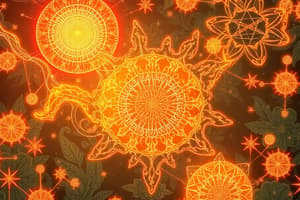Podcast
Questions and Answers
Which pigment is primarily responsible for the absorption of violet-blue and red light?
Which pigment is primarily responsible for the absorption of violet-blue and red light?
- Chlorophyll a (correct)
- Chlorophyll b
- Carotenoids
- Accessory pigments
What is the main role of carotenoids in plants?
What is the main role of carotenoids in plants?
- Transport electrons to the electron transport chain
- Split water molecules during photolysis
- Absorb blue-green light and protect cells as antioxidants (correct)
- Act as primary pigments converting light energy
What function does the antenna complex of the photosystem serve?
What function does the antenna complex of the photosystem serve?
- Replenishes the chlorophyll electrons
- Transfers electrons to the electron acceptor
- Splits water molecules to release oxygen
- Captures photons of light and transfers energy (correct)
Which wavelength of light does Photosystem II primarily absorb?
Which wavelength of light does Photosystem II primarily absorb?
What process occurs at Photosystem I to generate NADPH?
What process occurs at Photosystem I to generate NADPH?
What type of energy is defined as the energy of motion?
What type of energy is defined as the energy of motion?
Which statement accurately describes oxidation in a chemical reaction?
Which statement accurately describes oxidation in a chemical reaction?
According to the first law of thermodynamics, which of the following is true?
According to the first law of thermodynamics, which of the following is true?
What does a positive ΔG indicate about a chemical reaction?
What does a positive ΔG indicate about a chemical reaction?
How does the presence of an enzyme affect a chemical reaction?
How does the presence of an enzyme affect a chemical reaction?
What is indicated by a negative ΔG in a chemical reaction?
What is indicated by a negative ΔG in a chemical reaction?
What distinguishes exergonic reactions from endergonic reactions?
What distinguishes exergonic reactions from endergonic reactions?
Which of the following best describes entropy according to the second law of thermodynamics?
Which of the following best describes entropy according to the second law of thermodynamics?
What is the final electron acceptor in anaerobic respiration?
What is the final electron acceptor in anaerobic respiration?
Which type of fermentation involves the conversion of pyruvate into lactic acid?
Which type of fermentation involves the conversion of pyruvate into lactic acid?
What process must fatty acids undergo before entering the Krebs cycle?
What process must fatty acids undergo before entering the Krebs cycle?
Which of the following statements about ATP yield is correct?
Which of the following statements about ATP yield is correct?
What happens to the amino group of amino acids during catabolism?
What happens to the amino group of amino acids during catabolism?
Which of the following products can enter the Krebs cycle after catabolism of amino acids?
Which of the following products can enter the Krebs cycle after catabolism of amino acids?
Which statement accurately relates photosynthesis and respiration?
Which statement accurately relates photosynthesis and respiration?
What is the first step in the catabolism of fats?
What is the first step in the catabolism of fats?
What direction does DNA polymerase synthesize the new strand during replication?
What direction does DNA polymerase synthesize the new strand during replication?
What is the role of single-stranded binding proteins (SSBs) during DNA replication?
What is the role of single-stranded binding proteins (SSBs) during DNA replication?
What distinguishes continuous replication from discontinuous replication?
What distinguishes continuous replication from discontinuous replication?
What is the primary function of DNA polymerase III in DNA replication?
What is the primary function of DNA polymerase III in DNA replication?
What is the function of DNA ligase during DNA replication?
What is the function of DNA ligase during DNA replication?
What is the first step in DNA replication?
What is the first step in DNA replication?
Which enzyme is responsible for replacing RNA primers with DNA nucleotides on the lagging strand?
Which enzyme is responsible for replacing RNA primers with DNA nucleotides on the lagging strand?
How many origins of replication do eukaryotic genomes typically have?
How many origins of replication do eukaryotic genomes typically have?
How does DNA polymerase ensure that nucleotides added are correct during replication?
How does DNA polymerase ensure that nucleotides added are correct during replication?
What is the main reason prokaryotic replication is faster than eukaryotic replication?
What is the main reason prokaryotic replication is faster than eukaryotic replication?
What does the 3’ to 5’ exonuclease activity of DNA polymerase allow it to do?
What does the 3’ to 5’ exonuclease activity of DNA polymerase allow it to do?
What is the role of telomerase in eukaryotic DNA replication?
What is the role of telomerase in eukaryotic DNA replication?
What role does primase play in DNA replication?
What role does primase play in DNA replication?
What characteristic differentiates the chromosome structure of prokaryotes from that of eukaryotes?
What characteristic differentiates the chromosome structure of prokaryotes from that of eukaryotes?
Which enzymes perform functions similar to DNA polymerase III in eukaryotic DNA replication?
Which enzymes perform functions similar to DNA polymerase III in eukaryotic DNA replication?
What problem arises during the replication of linear chromosomes in eukaryotes?
What problem arises during the replication of linear chromosomes in eukaryotes?
What is the role of ATP synthase in the process of photophosphorylation?
What is the role of ATP synthase in the process of photophosphorylation?
Which molecule is primarily responsible for fixing carbon dioxide during the Calvin cycle?
Which molecule is primarily responsible for fixing carbon dioxide during the Calvin cycle?
What is the first stable product formed during the Calvin cycle?
What is the first stable product formed during the Calvin cycle?
How many turns of the Calvin cycle are needed to produce one molecule of glucose?
How many turns of the Calvin cycle are needed to produce one molecule of glucose?
What happens to the remaining G3P molecules after one is released from the Calvin cycle?
What happens to the remaining G3P molecules after one is released from the Calvin cycle?
What is the function of ferredoxin in the electron transport chain?
What is the function of ferredoxin in the electron transport chain?
Which of the following processes occurs in the stroma of the chloroplasts?
Which of the following processes occurs in the stroma of the chloroplasts?
Which enzyme catalyzes the fixation of carbon dioxide in the Calvin cycle?
Which enzyme catalyzes the fixation of carbon dioxide in the Calvin cycle?
Flashcards
Photosystem
Photosystem
A complex of pigments and proteins that capture light energy.
Antenna Complex
Antenna Complex
A group of accessory pigments, including chlorophyll b and carotenoids, that capture photons of light and transfer energy between pigment molecules.
Photosystem II (PSII)
Photosystem II (PSII)
This key pigment absorbs light (primarily at 680 nm) and excites electrons within the reaction center, leading to the splitting of water molecules.
Photosystem I (PSI)
Photosystem I (PSI)
Signup and view all the flashcards
Photolysis
Photolysis
Signup and view all the flashcards
Anaerobic respiration
Anaerobic respiration
Signup and view all the flashcards
Fermentation
Fermentation
Signup and view all the flashcards
Ethanol fermentation
Ethanol fermentation
Signup and view all the flashcards
Lactic acid fermentation
Lactic acid fermentation
Signup and view all the flashcards
Protein catabolism
Protein catabolism
Signup and view all the flashcards
Fat catabolism
Fat catabolism
Signup and view all the flashcards
Beta-oxidation
Beta-oxidation
Signup and view all the flashcards
Coenzyme A (CoA)
Coenzyme A (CoA)
Signup and view all the flashcards
DNA helicase
DNA helicase
Signup and view all the flashcards
Single-stranded binding proteins (SSBs)
Single-stranded binding proteins (SSBs)
Signup and view all the flashcards
DNA gyrase (topoisomerase in eukaryotes)
DNA gyrase (topoisomerase in eukaryotes)
Signup and view all the flashcards
Primase
Primase
Signup and view all the flashcards
Continuous replication
Continuous replication
Signup and view all the flashcards
Discontinuous replication
Discontinuous replication
Signup and view all the flashcards
Okazaki Fragments
Okazaki Fragments
Signup and view all the flashcards
DNA Ligase
DNA Ligase
Signup and view all the flashcards
Electron Transport Chain (ETC) in Photosynthesis
Electron Transport Chain (ETC) in Photosynthesis
Signup and view all the flashcards
Proton Gradient
Proton Gradient
Signup and view all the flashcards
Photophosphorylation
Photophosphorylation
Signup and view all the flashcards
Light-Dependent Reactions (Photosynthesis)
Light-Dependent Reactions (Photosynthesis)
Signup and view all the flashcards
NADPH
NADPH
Signup and view all the flashcards
Carbon Fixation
Carbon Fixation
Signup and view all the flashcards
3-Phosphoglycerate (PGA)
3-Phosphoglycerate (PGA)
Signup and view all the flashcards
Rubisco
Rubisco
Signup and view all the flashcards
Kinetic Energy
Kinetic Energy
Signup and view all the flashcards
Potential Energy
Potential Energy
Signup and view all the flashcards
Oxidation
Oxidation
Signup and view all the flashcards
Reduction
Reduction
Signup and view all the flashcards
Free Energy
Free Energy
Signup and view all the flashcards
The First Law of Thermodynamics
The First Law of Thermodynamics
Signup and view all the flashcards
The Second Law of Thermodynamics
The Second Law of Thermodynamics
Signup and view all the flashcards
Enzyme
Enzyme
Signup and view all the flashcards
DNA polymerase III
DNA polymerase III
Signup and view all the flashcards
Clamp loader and sliding clamp
Clamp loader and sliding clamp
Signup and view all the flashcards
DNA polymerase I
DNA polymerase I
Signup and view all the flashcards
Genome size and structure in replication
Genome size and structure in replication
Signup and view all the flashcards
Replication machinery in prokaryotes and eukaryotes
Replication machinery in prokaryotes and eukaryotes
Signup and view all the flashcards
Chromosome ends in replication
Chromosome ends in replication
Signup and view all the flashcards
Speed of replication in prokaryotes and eukaryotes
Speed of replication in prokaryotes and eukaryotes
Signup and view all the flashcards
Study Notes
Energy Flow
- Energy is the potential to do work
- Kinetic energy is the energy of motion
- Potential energy is stored energy
- Oxidation is the loss of electrons (lower energy)
- Reduction is the gain of electrons (higher energy)
- Redox reactions combine oxidation and reduction
- The first law of thermodynamics states that energy cannot be created or destroyed.
- The second law of thermodynamics states that entropy (disorder) is constantly increasing.
Calculating Energy
- ΔG° = ΔH° - TAS°
- ΔG = free energy (energy available to do work)
- ΔH = change in enthalpy (energy associated with chemical bonds)
- T = absolute temperature (in Kelvin)
- ΔS = change in entropy (disorder)
- If ΔG is negative, energy is released (exergonic)
- If ΔG is positive, energy is required (endergonic)
Enzymes
- Enzymes speed up chemical reactions (catalysts)
- Enzymes are not consumed or changed in the process
- Enzymes lower activation energy, accelerating reactions
- Enzymes bind substrates at the active site
Biochemical Pathways and Feedback Inhibition
- Biochemical pathways are linked reactions with products serving as substrates
- Feedback inhibition: the end product of a pathway regulates the earlier steps (often the first) in the pathway
- Feedback prevents overproduction of a specific product, conserving energy
- Products bind to an allosteric site of the enzyme, changing its shape and inhibiting activity
ATP
- ATP (adenosine triphosphate) stores energy in the covalent bonds between its phosphate groups
- ATP releases energy when a phosphate group is removed (hydrolysis)
- Cells rely on continuous regeneration of ATP through cellular respiration
Energy From Electrons
- Autotrophs convert the sun's energy into chemical energy (e.g., plants)
- Heterotrophs obtain energy by consuming other organisms
- Electron carriers, like NAD+, accept and transfer electrons efficiently in cellular respiration
Cellular Respiration - Glycolysis
- Glycolysis (splitting of glucose) occurs in the cytosol
- In glycolysis, a 6-carbon glucose molecule is broken down into two 3-carbon pyruvate molecules
- ATP is produced (net gain 2 ATP)
- NADH molecules are produced
Cellular Respiration - Pyruvate Oxidation
- Pyruvate oxidation occurs in the mitochondrial matrix
- Pyruvate is oxidized to form acetyl-CoA, releasing CO2
- NADH is produced
- Acetyl-CoA enters the Krebs cycle
Cellular Respiration - Krebs Cycle
- Occurs in the mitochondrial matrix
- Acetyl-CoA combines with oxaloacetate to form citrate
- Through several reactions CO2, NADH, and FADH2 are released
- Results in ATP production (via substrate-level phosphorylation)
Cellular Respiration - Electron Transport Chain and Chemiosmosis
- Occurs in the inner mitochondrial membrane
- Electrons from NADH and FADH2 move through the ETC, pumping H+ ions into the intermembrane space
- H+ gradient creates a proton motive force
- ATP synthase uses the flow of H+ ions to produce ATP
Photosynthesis
- Photosynthesis converts light energy into chemical energy
- Light-dependent reactions capture light energy and synthesize ATP and NADPH; water is split, generating oxygen
- Calvin cycle uses ATP and NADPH to convert CO2 into glucose
DNA Replication
- DNA replication is semiconservative, producing two identical DNA molecules from one original molecule
- DNA polymerase synthesizes new DNA strands (5'-3' direction)
- Leading strand synthesis is continuous; lagging strand synthesis is discontinuous (Okazaki fragments)
Studying That Suits You
Use AI to generate personalized quizzes and flashcards to suit your learning preferences.




